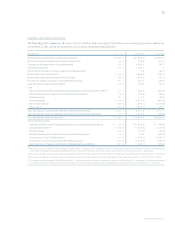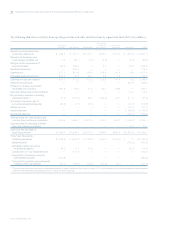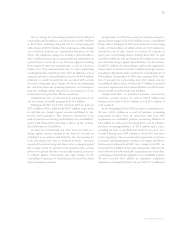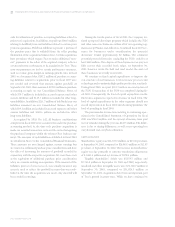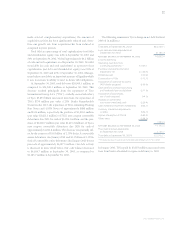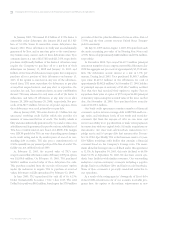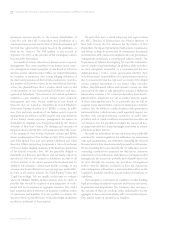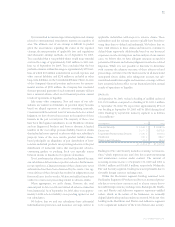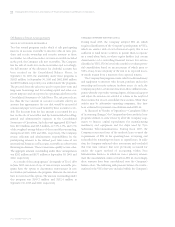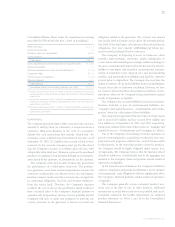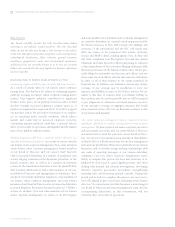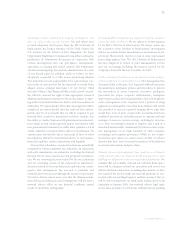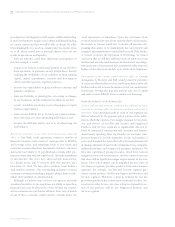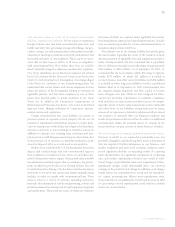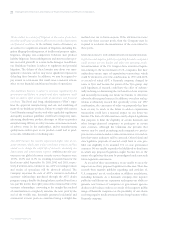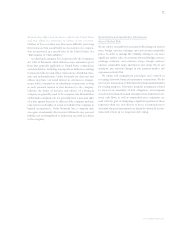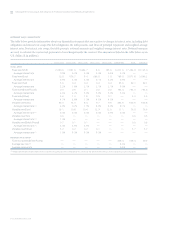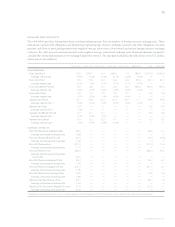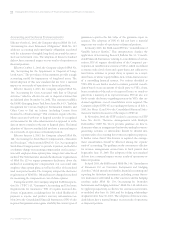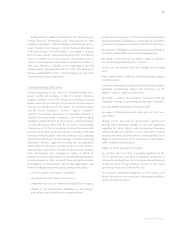ADT 2003 Annual Report Download - page 57
Download and view the complete annual report
Please find page 57 of the 2003 ADT annual report below. You can navigate through the pages in the report by either clicking on the pages listed below, or by using the keyword search tool below to find specific information within the annual report.
55
Consolidated Balance Sheet under the transitional accounting
prescribed by FIN 46 effective July 1, 2003 ($ in millions):
Restricted cash $««21.7
Accounts receivable 7.5
Property, plant and equipment 433.8
Other assets (1) 28.2
Total assets $491.2
Loans payable and current maturities of long-term debt $««10.6
Accounts payable 2.1
Accrued expenses and other current liabilities (2) (31.6)
Long-term debt 551.6
Other long-term liabilities (3) (12.8)
Minority interest 46.4
Total liabilities 566.3
Cumulative effect of accounting change, net of tax $«(75.1)
(1) Includes the elimination of $16.2 million of equity investments related to joint
ventures previously recorded under the equity method which are now consolidated
under FIN 46.
(2) Includes the elimination of $32.7 million of accrued expenses associated with syn-
thetic leases previously recorded as operating leases which are now recorded as
capital leases under FIN 46.
(3) Includes the elimination of $14.7 million of long-term liabilities associated with
synthetic leases previously recorded as operating leases which are now recorded as
capital leases under FIN 46.
GUARANTEES
The Company may, from time to time, enter into sales contracts
whereby it will buy back (at a discount) a transaction from a
customer’s third-party financier in the event of a customer’s
default. For such transactions that include “shared risk,” the
Company accrues a liability based on historical loss data. As of
September 30, 2003, $3.2 million was accrued related to these
contracts. In the event the Company must pay for this shared
risk, the Company’s recourse is as follows: place the lease with
a financially viable third-party financier; repossess the purchased
products or equipment; seek payment through a personal guar-
antee issued by the customer; or, alternatively, sue the customer.
The Company’s Fire and Security business has guaranteed
the performance of a third-party contractor. The perform-
ance guarantee arose from contract negotiations, because the
contractor could provide cost-effective service on a telecommu-
nications contract. In the event the contractor does not perform
its contractual obligations, Tyco Fire and Security would per-
form the service itself. Therefore, the Company’s exposure
would be the cost of any services performed, which would not
have a material effect to the Company’s financial position or
annual results of operations. Because it is not probable that the
Company will have to make any payments or perform any
services pursuant to the guarantee it has not recorded any
obligation related to the guarantee. The contract was entered
into in July 2002 and expires at the end of the warranty period,
July 2004. If the third-party subcontractor does not perform its
obligations, Tyco may consider withholding any future pay-
ment for work performed by the contractor.
The Company, in disposing of assets or businesses, often
provides representations, warranties and/or indemnities to
cover various risks including, for example, unknown damage to
the assets, environmental risks involved in the sale of real estate,
liability to investigate and remediate environmental contami-
nation at hazardous waste disposal sites and manufacturing
facilities, and unidentified tax liabilities and legal fees related to
periods prior to disposition. The Company does not have the
ability to estimate the potential liability from such indemnities
because they relate to unknown conditions. However, we have
no reason to believe that these uncertainties would have a mate-
rial adverse effect on the Company’s financial position, annual
results of operations or liquidity.
The Company has recorded liabilities for known indemni-
fications included as part of environmental liabilities. See
“Liquidity and Capital Resources
—
Commitments and Contin-
gencies” above for a discussion of these liabilities.
The Company has guaranteed the fair value of certain vessels
not to exceed $235 million and has accrued $10.4 million and
$4.4 million as of September 30, 2003 and 2002, respectively,
based on its estimate of fair value of the vessels (see “Liquidity and
Capital Resources
—
Commitments and Contingencies” above).
Due to the Company’s downsizing of certain operations as
part of restructuring plans, acquisitions, or otherwise, the Com-
pany has leased properties which it has vacated but has sublet
to third parties. In the event third parties vacate the premises,
the Company would be legally obligated under master lease
arrangements. The Company believes that the financial risk of
default by sublessors is individually and in the aggregate not
material to the Company’s financial position, annual results of
operations or liquidity.
In the normal course of business, the Company is liable for
contract completion and product performance. In the opinion
of management, such obligations will not significantly affect
the Company’s financial position, annual results of operations
or liquidity.
The Company generally accrues estimated product war-
ranty costs at the time of sale. In other instances, additional
amounts are recorded when such costs are probable and can be
reasonably estimated. For further information on estimated
product warranty, see Notes 1 and 20 to the Consolidated
Financial Statements.
TYCO INTERNATIONAL LTD.


